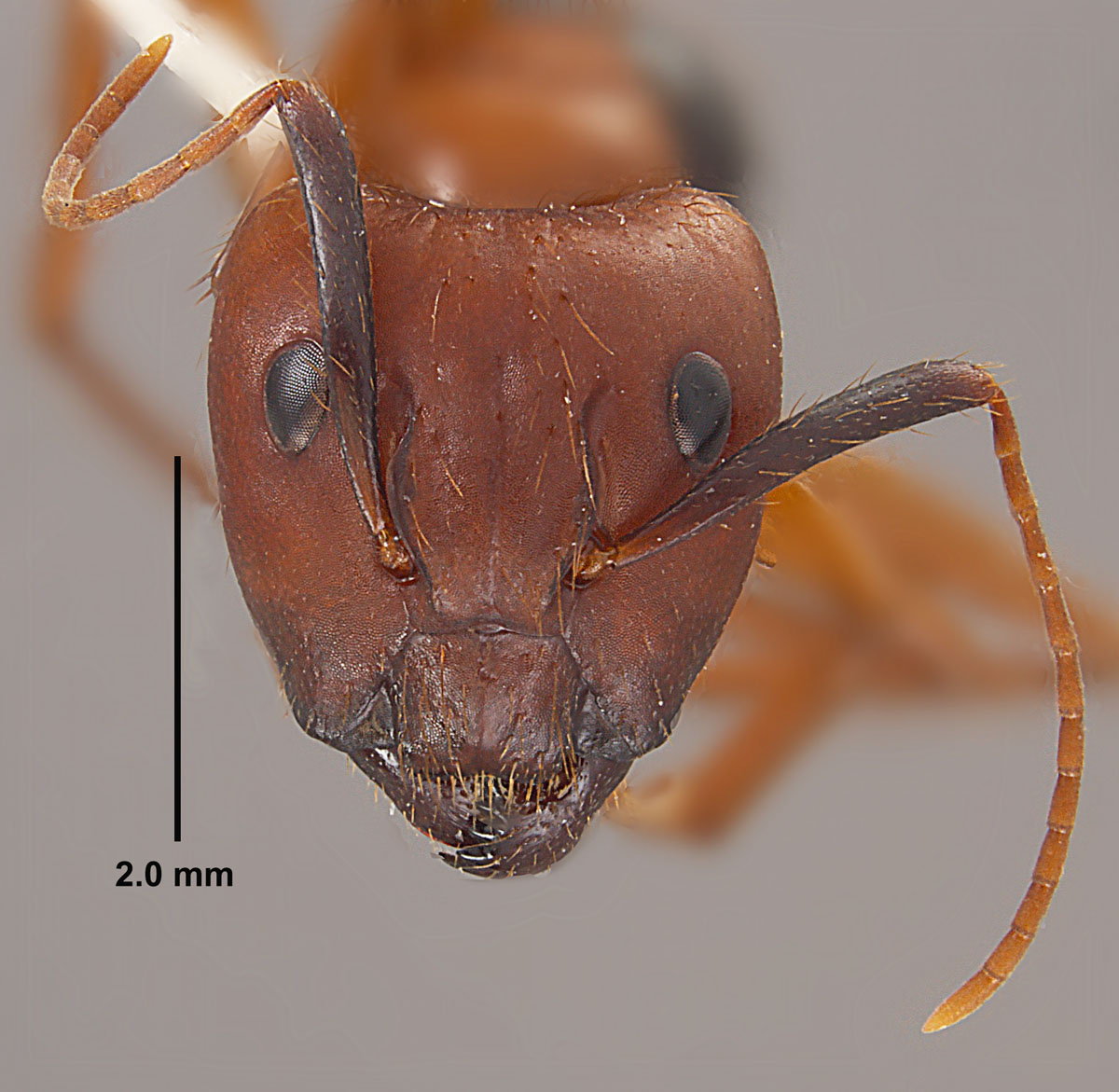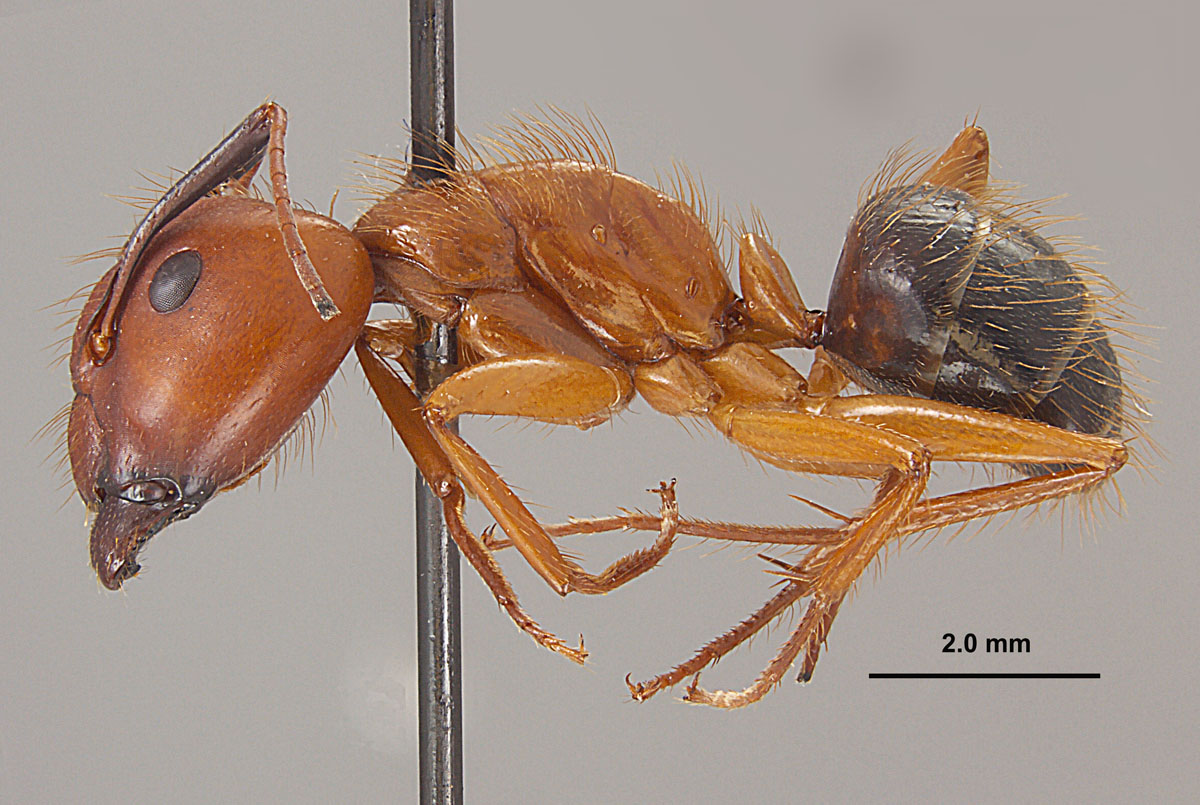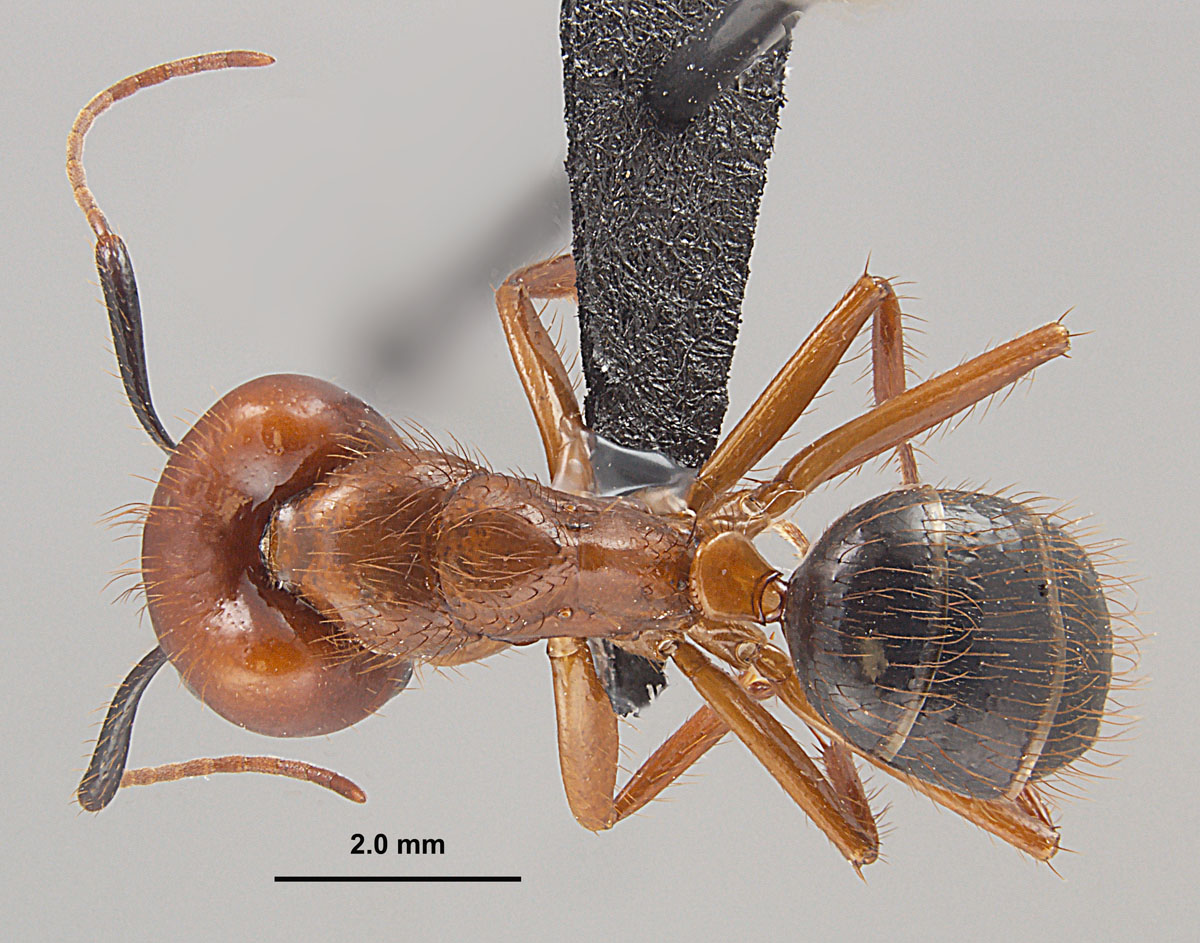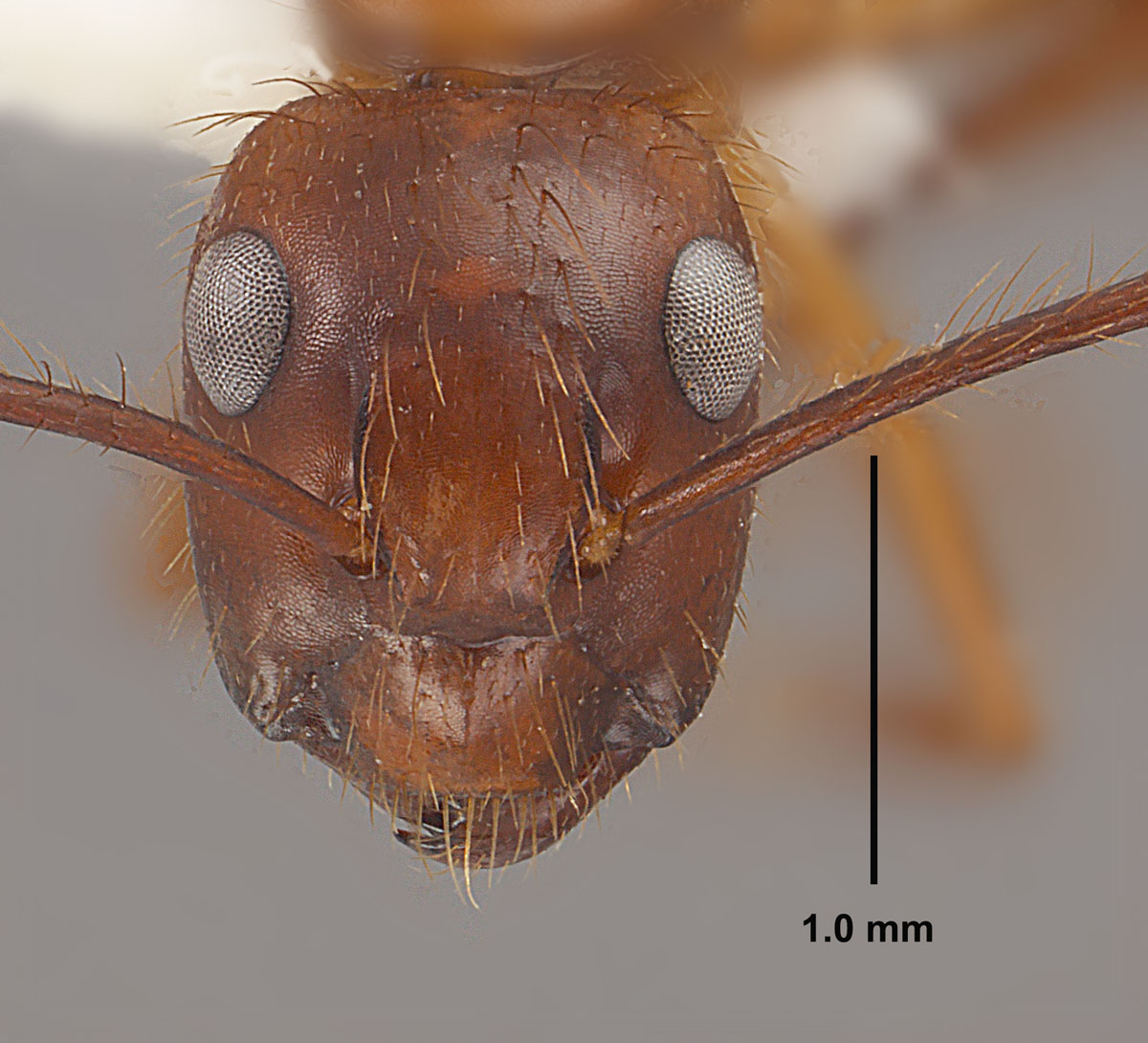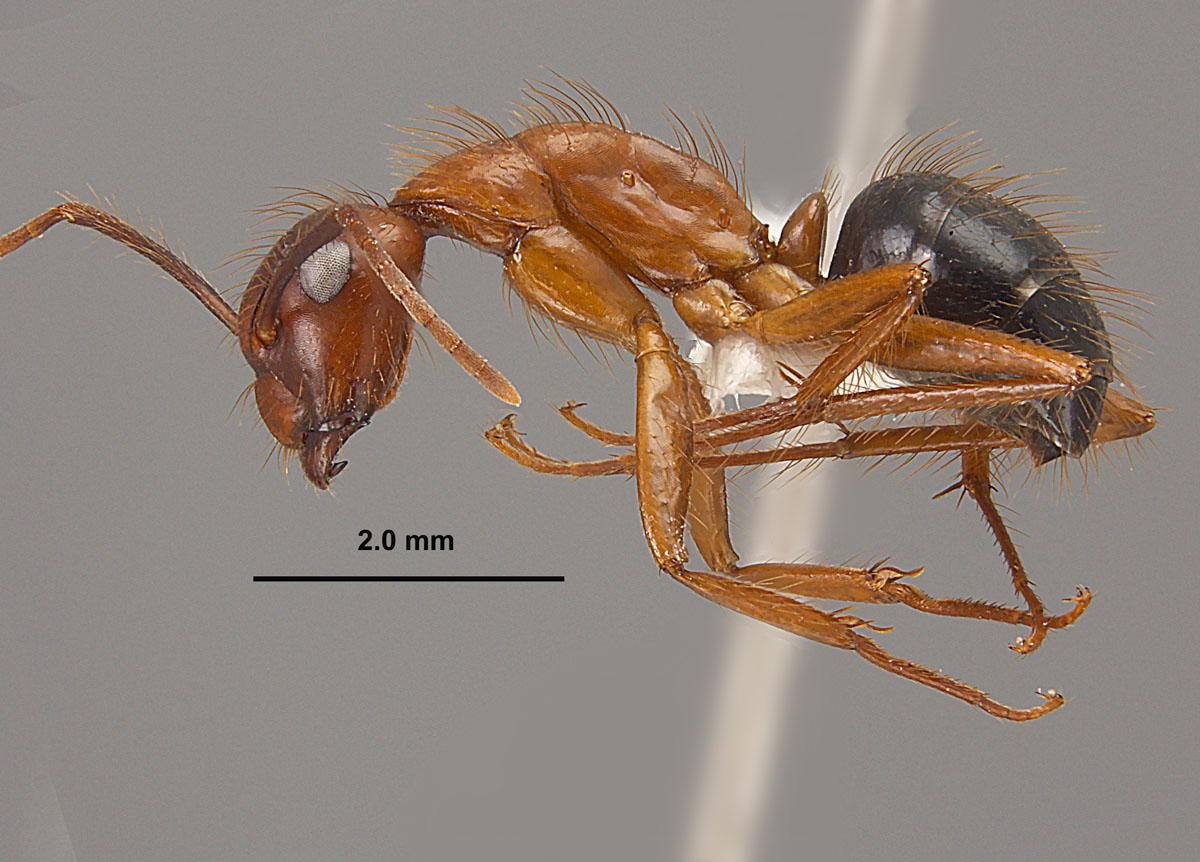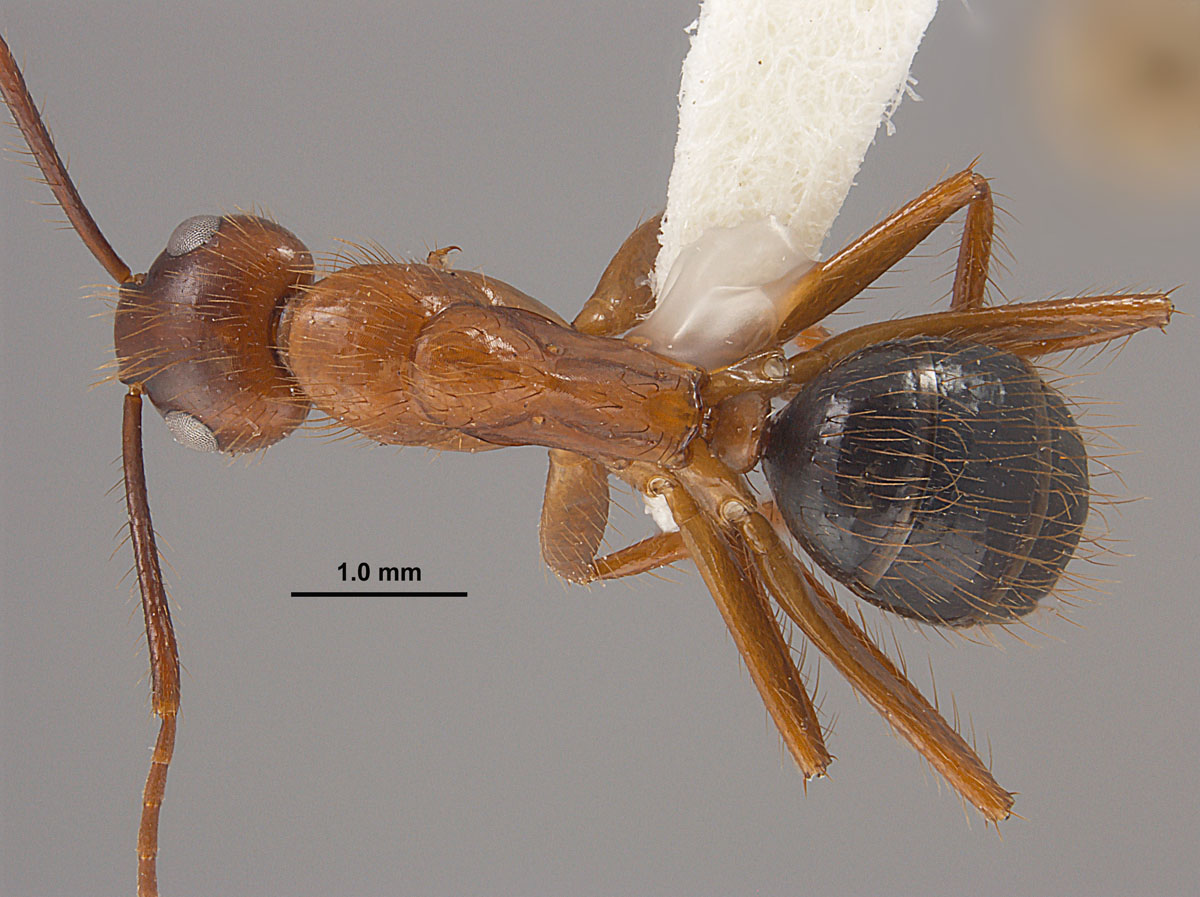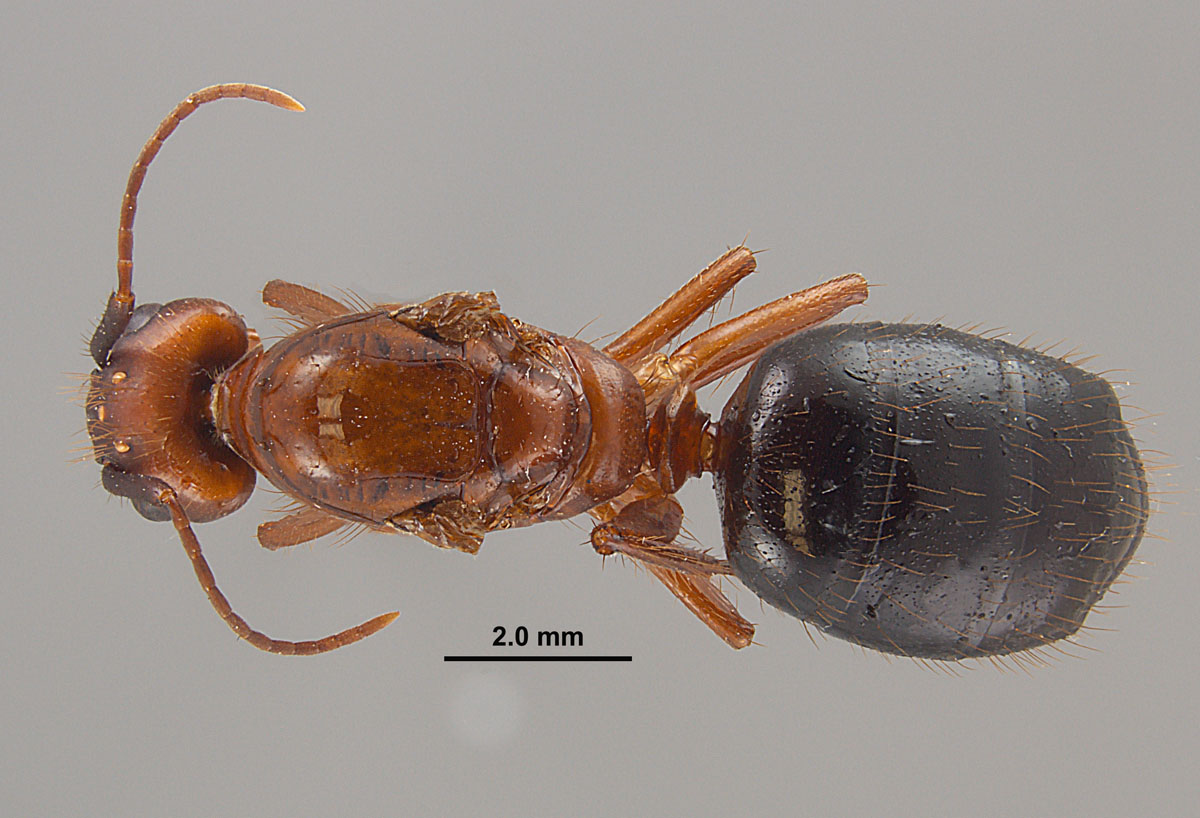Subfamily FORMICINAE Author: Nicole Rasoamanana and Joe A. MacGown |
|||
Introduction
Camponotus Mayr, 1861, commonly known as carpenter ants, is a large and widespread genus of polymorphic ants (Bolton 1995). More than 900 species are recognized globally, with approximately 50 reported from the United States (Hansen and Klotz 2005), and about 20 occurring east of the Mississippi River (Deyrup 2003; Smith 1979).
Camponotus floridanus belongs to the subgenus Myrmothrix Emery, 1893. This subgenus is characterized by the following combination of characters: medium to large species; head with sides roughly parallel and occipital margin rounded; vertex not depressed; major workers with the head broadened posteriorly, sometimes weakly notched; minor workers with head parallel–sided or slightly narrowed posteriorly; clypeus strongly carinate, its anterior margin produced into a pronounced, usually rectangular lobe; mandibles typically bearing 6–7 teeth; mesosoma dorsum evenly arched in profile; integument generally matte and clothed with dense pubescence; body and appendages usually with abundant setae; tarsi not compressed; nests typically in soil or beneath stones.
This Nearctic species is distributed in the southeastern United States, inhabiting coastal dunes, pine–oak woodlands, and sandy savannas, and may also occur in disturbed or residential habitats.
Taxonomic History
Camponotus floridanus (Buckley, 1866) valid
Formica floridana Buckley, 1866: 161 (w.) U.S.A. (Florida).
Primary type material: Syntype workers (number not stated), U.S.A.: Florida (E. Norton); depository unknown; no material known to exist (Creighton 1950: 396).
Combination in Camponotus: Mayr, 1886: 423.
Combination in Camponotus (Myrmothrix): Emery, 1925: 108.
As subspecies of Camponotus atriceps: Mayr, 1886: 423; Cresson, 1887: 256; Emery, 1893b: 231.
As subspecies of Camponotus abdominalis: Emery, 1893b: 219 (footnote); Emery 1893, 670; Emery, 1896: 372 (in list); Wheeler, 1902: 21; Wheeler, 1910a: 571; Wheeler, 1913d: 117; Emery, 1925d: 108; Smith, 1930, 6; Wheeler, 1932a: 15; Santschi, 1936b: 213; Creighton, 1950: 396; Smith, 1951: 844; Smith, 1958: 145; Wilson, 1964: 11; Smith, 1967: 366; Kempf, 1972: 60; Smith, 1979: 1431; Deyrup & Trager, 1986: 219.
Junior synonym of Camponotus abdominalis: Hashmi, 1973b: 82; Brandão 1991: 334.
Status as species: Dalla Torre, 1893: 231; Wheeler, 1910g: 325 (redescription); Deyrup et al., 1989: 100; Bolton, 1995: 100; Deyrup, 2003: 44; Hansen & Klotz, 2005: 94; MacGown & Forster, 2005: 66; MacGown et al., 2007: 18; Deyrup, 2017: 189.
Senior synonym of Camponotus atriceps yankee Forel, 1885: Mayr, 1886: 423; Emery, 1896: 372; Wheeler, 1910: 325; Emery, 1925: 108; Creighton, 1950: 396; Smith, 1951: 844; Smith, 1979: 1431; Bolto,n 1995: 100.
Common name
Florida carpenter ant
Diagnosis
Camponotus floridanus can be distinguished from other southeastern Camponotus by its relatively large size, distinct bicoloration, and dense covering of suberect golden setae over the entire body. Based on setation, it may be confused with Camponotus atriceps, but C. atriceps has a uniformly yellow integument. It may also resemble C. discolor in color; however, C. discolor has only a few pairs of standing hairs on the dorsum and no setae on the appendages. Furthermore, minor workers of C. floridanus are approximately the same size as major workers of C. discolor, providing an additional distinguishing character.
Identification
Descriptions for each caste are based on examination of MEM specimens.
Minor worker. TL: 5.96–6.25 mm; HL: 1.49–1.71 mm; HW: 1.15–1.32 mm; SL: 1.67–1.98 mm; ML: 2.17–2.51 mm; EL: 0.39–0.45 mm (n=5, MEM specimens).
Head longer than broad in full–face view; lateral margins subparallel, tapering anteriorly; occipital margin straight to weakly convex. Eyes large, distinctly protruding, with posterior margin positioned at approximately the posterior one–fourth of head length. Frontal carinae closely spaced and subparallel. Clypeus carinate, with distinct anterolateral angles and a bluntly produced anteromedian margin. Mandibles with 5–6 teeth. Antennal scape long, extending beyond the posterolateral corner of the head by about half its length. Mesosoma low and slender in profile; dorsum evenly arcuate; propodeum smoothly rounded without angular break. Petiole with cuneate node, anterior and posterior faces weakly convex. Standing pilosity coarse, erect, and somewhat uneven in length, abundant on head and mesosoma; antennal scape with shorter, more uniform hairs. Pubescence short and dilute on head and mesosoma, more distinct and appressed on gaster. Head ferruginous red; mandibles, antennal scapes, basal malar area, and clypeus dark brown. Mesosoma, funiculus, and legs yellowish red. Gaster dark brown to black, with light brown patches on first sternite.
Major worker. TL: 8.89–10.44 mm; HL: 2.58–3.28 mm; HW: 2.32–3.34 mm; SL: 1.82–2.56 mm; 2.8–3.78 mm; EL: 0.41–0.64 mm (n=5, MEM specimens).
Head nearly as long as broad in full–face view; lateral margins feebly convex and tapering anteriorly; occipital margin weakly concave medially. Eyes relatively flattened, positioned slightly posterior to midlength of the head. Clypeus carinate, anterior margin produced into a short, rectangular lobe, straight to weakly concave. Frontal carinae lyrate. Mandibles with 5–6 teeth. Antennal scape short, reaching the occipital corner; flattened basally, gradually broadened apically. Mesosoma robust; dorsal outline interrupted by a shallow promesonotal suture. Propodeum with obtuse angle, dorsum and declivity subequal in length. Petiole squamiform with blunt apex; anterior face short and converging to the summit, posterior face straight. Mandibles opaque, finely striate, sparsely punctate; teeth smooth and shining. Head opaque, densely and minutely punctate. Pilosity and coloration similar to minor worker.
Queen. TL: 12.33–14.05 mm; HL: 2.74–3.04 mm; HW: 2.72–2.96 mm; SL: 2.35–2.52 mm; ML: 4.52– 5.33 mm; EL: 0.66–0.76 mm (n=5, MEM specimens).
Head broadened posteriorly in full–face view; lateral margins straight, tapering anteriorly; occipital margin straight. Eyes strongly protruding, positioned posterior to midlength of head; ocelli well developed. Frontal carinae, clypeus, and mandibles as in major worker. Antennae 12–segmented; scape long, surpassing occipital margin by approximately one–third its length, flattened basally and expanded apically. Mesosoma robust; pronotal dorsum nearly vertical, continuous with dorsally flattened mesoscutum; mesoscutellum smoothly convex, higher than propodeal dorsum. Propodeal angle rounded; declivity about twice as long as dorsal face. Petiole compressed anteroposteriorly, dorsal margins sharp, slightly notched medially. Head finely foveolate; pronotum, propodeum, petiole, and gaster imbricate; mesoscutum and mesoscutellum smooth and shiny. Head reddish–brown; mandibles, anterolateral corners of clypeus, and scape dark brown; mesosoma, petiole, legs, and lower portion of first tergite and first sternite yellowish brown. Suberect golden hairs present on vertex, occiput, promesonotal suture, mesosoma dorsum, petiolar edge, and gaster; absent on pronotal dorsum.
Male. TL: 6.66–7.72 mm; HL: 1.26–1.4 mm; HW: 1.10–1.20 mm; SL: 1.56–1.70 mm; ML: 2.84–3.40 mm; EL: 0.51–0.56 mm (n=5, MEM specimens).
Head longer than broad in full–face view; anterolateral margins anterior to eyes parallel; occipital margin convex. Eyes large and protruding, breaking lateral outline of head; ocelli well developed, lateral ocelli just below occipital margin. Frontal carinae short, straight, and parallel. Clypeus with short, rounded–rectangular median lobe. Mandibles with a single apical tooth followed by one denticle. Antennae 13–segmented; scape long, surpassing occipital margin by more than half its length. Mesosoma robust in lateral view; pronotal margin vertical; mesoscutum anteriorly convex and dorsally flattened; mesoscutellum convex; propodeum short, dorsal and declivitous faces meeting at a rounded angle. Petiole nodiform with rounded apex. Body finely foveolate; gaster smoother and more shining. Entire body brown. Scattered filiform hairs present on clypeus, vertex, pronotum, mesoscutum, mesoscutellum, petiole dorsum, and gaster. Wings. Forewing with well–developed pterostigma; fused subcostal and radial veins (Sc+R) present; radial sector (Rs) reaching costal margin; medial–cubital vein (M+Cu) present; 1m–cu, 2rs–m, and Rs+M absent; anal vein (A) longer than M+Cu. Hindwing with fused R+Rs, M+Cu present; cu–a present; anal vein longer than M+Cu.
Biology and Economic Importance
Camponotus floridanus inhabits a wide range of coastal and inland habitats, including foredunes, hind dunes, scrub and dune habitats, pine–oak dune woodlands, longleaf pine savannas, and natural hardwood hammocks. It also occurs in pitcher plant bogs, coastal dune vegetation on Opuntia stricta, sandy landscaped areas, and along marsh trails. Colonies are typically found in sandy soils, under or within rotting wood, and in decaying stumps, particularly those of Pinus species. Nests have also been reported from sandy areas beside roads, vacant residential lots, and coastal residential zones, and occasionally from disturbed sites such as swimming pools, indicating a high tolerance for environmental disturbance. Biologically, this species contributes to soil aeration, organic matter decomposition, and nutrient cycling, while also participating in seed dispersal and local food web dynamics. Although occasionally encountered near human dwellings, its ecological role in maintaining habitat structure and ecosystem health underscores its overall environmental importance. Specimens have been collected using various methods, including Blacklight traps, Malaise traps, general collecting, UV light, pitfall traps, sweeping, and hotdog baiting.
Pest Status
Camponotus floridanus is not considered a major structural or agricultural pest, although it may occasionally occur in residential and recreational areas, such as coastal properties, landscaped gardens, and swimming pools. Colonies nesting in soil, decaying wood, or stumps near human structures can sometimes be a minor nuisance when foraging indoors or around food sources. However, infestations are generally localized and non–destructive, with little evidence of economic damage. In most cases, the species remains ecologically beneficial, contributing to soil improvement and natural pest control. Its presence near dwellings is usually incidental and does not warrant control measures except in sensitive areas where human activity is directly affected.
Distribution
Restricted to the Nearctic region, Camponotus floridanus is known from the southeastern United States, including Florida, South Carolina, Georgia, Alabama, Mississippi, and Texas.
Literature Cited
Bolton, B. 1995. A new general catalogue of the ants of the world. Cambridge, Mass.: Harvard University Press, 504 pp.
Bolton, B. 2025. An online catalog of the ants of the world. Available from https://antcat.org. (accessed 4 November 2025).
Brandão, C. R. F. 1991. Adendos ao catálogo abreviado das formigas da região Neotropical (Hymenoptera: Formicidae). Revista Brasileira deEntomologia 35:319–412.
Buckley, S. B. 1866. Descriptions of new species of North American Formicidae. Proceedings of the Entomological Society of Philadelphia 6:152–172.
Creighton, W. S. 1950. The ants of North America. Bulletin of the Museum of Comparative Zoology 104:1–585.
Cresson, E. T. Sr. 1887. Synopsis of the families and genera of the Hymenoptera of America, north of Mexico, together with a catalogue of the described species, and bibliography. Transactions of the American Entomological Society, Suppl. Vol. 1887:1–351.
Dalla Torre, K. W. 1893. Catalogus Hymenopterorum hucusque descriptorum systematicus et synonymicus. Vol. 7. Formicidae (Heterogyna). Leipzig: W. Engelmann, 289 pp.
Deyrup, M. 2003. An updated list of Florida ants (Hymenoptera: Formicidae). Florida Entomologist 86:43––48.
Deyrup, M. 2017. Ants of Florida. Identification and natural history. Boca Raton, Florida: CRC Press (Taylor & Francis group), 423 pp.
Deyrup, M.; Johnson, C.; Wheeler, G. C.; Wheeler, J. 1989. A preliminary list of the ants of Florida. Florida Entomologist 72:91–101.
Deyrup, M., Trager, J. 1986. Ants of the Archbold Biological Station, Highlands County, Florida (Hymenoptera: Formicidae). Florida Entomologist 69:206–228.
Emery, C. 1893a. Beiträge zur Kenntniss der nordamerikanischen Ameisenfauna. Zoologische Jahrbücher. Abteilung für Systematik, Geographie und Biologie der Tiere 7:633–682.
Emery, C. 1893b. [Untitled. Taxonomic changes in various genera attributed to Emery.]. Pp. 4–266 in: Dalla Torre, K. W. 1893. Catalogus Hymenopterorum hucusque descriptorum systematicus et synonymicus. Vol. 7. Formicidae (Heterogyna). Leipzig: W. Engelmann, 289 pp.
Emery, C. 1896. Saggio di un catalogo sistematico dei generi Camponotus, Polyrhachis e affini. Memorie della Reale Accademia delle Scienze dell'Istituto di Bologna (5)5:363–382 [pagination of separate: 761–780].
Emery, C. 1925. Hymenoptera. Fam. Formicidae. Subfam. Formicinae. Genera Insectorum 183:1–302.
Hansen, L. D.; Klotz, J. H. 2005. Carpenter ants of the United States and Canada. Ithaca, New York: Cornell University Press, xiii + 204 pp.
Hashmi, A. A. 1973. A revision of the Neotropical ant subgenus Myrmothrix of genus Camponotus (Hymenoptera: Formicidae). Studia Entomologica 16:1–140.
Kempf, W. W. 1972. Catálogo abreviado das formigas da região Neotropical. Studia Entomologica 15:3–344.
MacGown, J. A., Brown, R. L., Hill, J. G, Layton, B. 2007. Carpenter ants of Mississippi. Mississippi Agricultural and Forestry Experiment Station Bulletin 1158:1–35.
MacGown, J. A.; Forster, J. A. 2005. A preliminary list of the ants (Hymenoptera: Formicidae) of Alabama, U. S. A. Entomological News 116:61–74.
Mayr, G. 1886. Die Formiciden der Vereinigten Staaten von Nordamerika. Verhandlungen der Kaiserlich–Königlichen Zoologisch–Botanischen Gesellschaft in Wien 36:419–464.
Santschi, F. 1936. Contribution à l'étude des fourmis de l'Amérique du Sud. Revista de Entomologia (Rio de Janeiro) 6:196–218.
Smith, D. R. 1979. Superfamily Formicoidea. Pp. 1323–1467 in: Krombein, K. V.; Hurd, P. D.; Smith, D. R.; Burks, B. D. (eds.) 1979. Catalog of Hymenoptera in America north of Mexico. Volume 2. Apocrita (Aculeata). Washington, D.C.: Smithsonian Institution Press, pp. i–xvi, 1199–2209.
Smith, M. R. 1930. A list of Florida ants. Florida Entomologist 14:1–6.
Smith, M. R. 1951. Family Formicidae. Pp. 778–875 in: Muesebeck, C. F. W.; Krombein, K. V.; Townes, H. K. (eds.) 1951. Hymenoptera of America north of Mexico. Synoptic catalogue. United States Department of Agriculture. Agriculture Monograph 2:1–1420.
Smith, M. R. 1958. Family Formicidae. Pp. 108–162 in: Krombein, K. V. (ed.) 1958. Hymenoptera of America north of Mexico. Synoptic catalogue. First supplement. United States Department of Agriculture. Agriculture Monograph 2 (suppl. 1):1–305.
Smith, M. R. 1967. Family Formicidae. Pp. 343–374 in: Krombein, K. V.; Burks, B. D. (eds.) 1967. Hymenoptera of America north of Mexico. Synoptic catalog. Second supplement. United States Department of Agriculture. Agriculture Monograph 2 (suppl. 2):1–584.
Wheeler, W. M. 1902. A consideration of S. B. Buckley's "North American Formicidae". Transactions of the Texas Academy of Sciences 4:17–31.
Wheeler, W. M. 1910a. Ants: their structure, development and behavior. New York: Columbia University Press, xxv + 663 pp.
Wheeler, W. M. 1910b. The North American ants of the genus Camponotus Mayr. Annals of the New York Academy of Sciences 20:295–354.
Wheeler, W. M. 1913. Ants collected in Georgia by Dr. J. C. Bradley and Mr. W. T. Davis. Psyche (Cambridge) 20:112–117.
Wheeler, W. M. 1932. A list of the ants of Florida with descriptions of new forms. Journal of the New York Entomological Society 40:1–17.
Wilson, E. O. 1964. The ants of the Florida Keys. Breviora 210:1–14.


